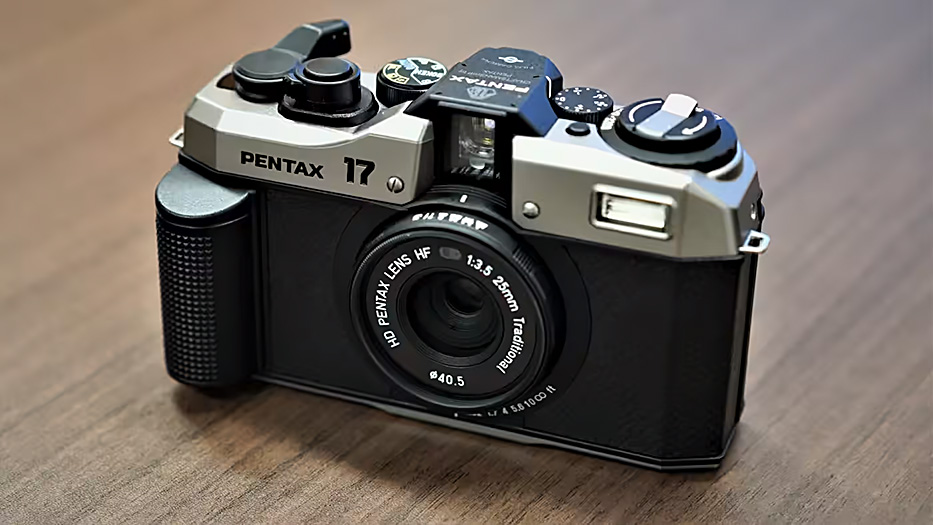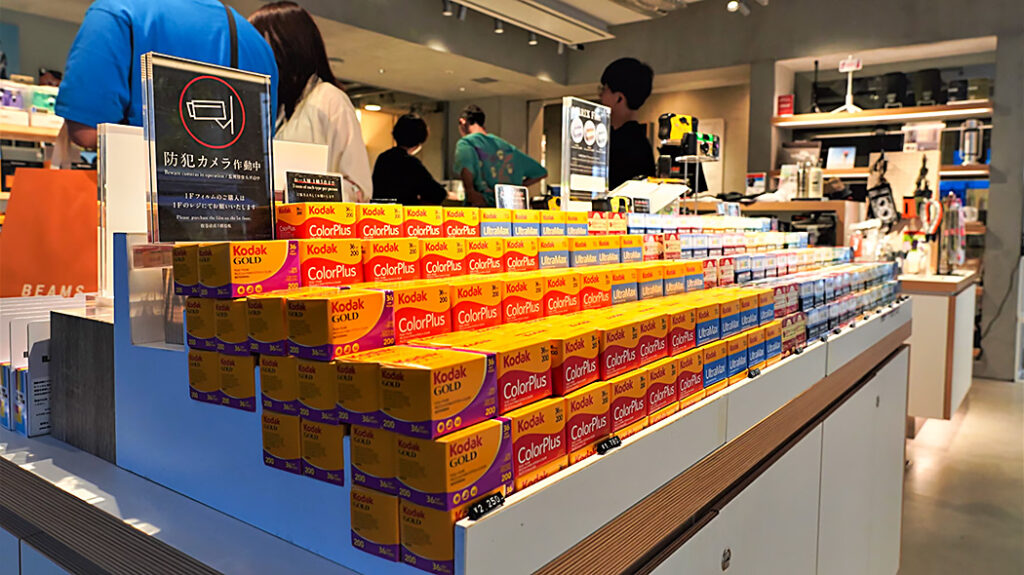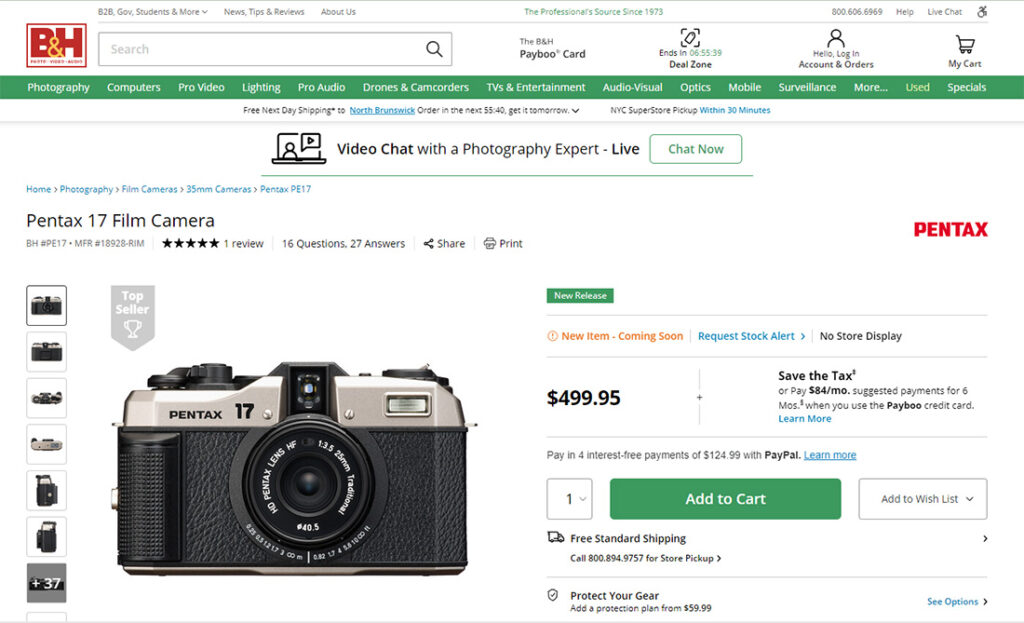
Interesting news out of Japan as we learn that Ricoh, a large Japanese imaging company that owns the Pentax camera brand, is launching its first film camera under the Pentax brand in over 20 years. This new model, the Pentax 17, will launch first in overseas markets in June, and then in the domestic (Japan) market in July.
See more on the re-emergence of analog film cameras by Pentax
By now, many Strata-gee readers will likely note that the re-emergence of analog formats is becoming a common theme for me. In February, I noted the growing sales of analog cassette tapes happening around the world. Before that, Strata-gee was one of the first to report on the surprising resurging growth of vinyl record and turntable sales.
When the story on the growing demand for cassette tapes ran, I received a fair amount of snide, sarcastic comments, both publicly and privately. Yet, it is clear to me that – for whatever reason – there is a good share of the consumer market interested in obtaining analog products. This story on new analog film cameras beginning to be marketed is just one more example of a growing interest in analog formats.
For Those Who Know Cameras, Not a Big Surprise
Of all the analog comeback stories I’ve covered, this one is perhaps the least surprising to me. As many readers know, photography has been a hobby of mine for several decades. When digital cameras finally supplanted film, the reality is that film never really went away. While manufacturers eventually stopped making new film cameras, there is and has been a large, active, and even vibrant enthusiast community of photographers who continued to use analog film, preferring the look of an analog capture to digital.
In fact, the market for used cameras, parts, and film has remained fairly healthy over the years, with certain used iconic film cameras commanding high resale values. But, also, manufacturers began to reintroduce certain point-and-click film cameras, which remain popular for use by guests at weddings, parties, concerts, or other such live events. Yes, these are mostly single-use cameras – but they use analog film and offer processing (many drugstores and camera shops also continue to offer film processing).
Targeting the Younger Generation
The all-new Ricoh Pentax 17 is a compact film camera that the company is targeting at those Generation Z customers (12-27 years old) who are looking for a retro experience “that stands in contrast to today’s digital world where photos can be snapped with smartphones.
The company expects the Pentax 17 to sell for around ¥88,000 (~$556) in the local market.
A film camera is not something nostalgic for our target customers in their teens and 20s. In fact, it is something completely new.
Akihide Tabei, Ricoh Imaging Company Director

Introducing a New Generation to Film Quality
Ricoh executives told the media that they seek to introduce young people “to the kind of picture quality unique to film” and to help them discover “the simple pleasure of manually winding film after each release,” according to a report by the Nikkei. This is not a high-end camera, but more of a fun consumer camera that is compact enough to go with you everywhere, while delivering a higher quality image than single-use cameras.
It uses standard 35mm roll film, but it incorporates a unique half-frame shooting system that cuts each frame in half, converting it to a vertically-oriented 17mm x 24mm format (which is where the camera gets its model name from). This is perhaps a nod to shooting images on your phone vertical style. Thanks to its half-frame shooting design, you get twice as many photos from a standard roll of film (i.e. 72 photos on a 36-shot roll of film). This also serves to lower the cost, as film costs have remained fairly high. Users will be able to share their analog shots on social media, via a conversion service offered by electronics shops or camera stores.
Strong Network of Dealers Lined Up Globally
Although the model is brand new, the company has been successful in gaining worldwide distribution. Here in the U.S. major camera dealer B&H Photo is taking advance orders for the Pentax 17 at $499.95. It says that the camera is “shipping soon.” I also saw the Pentax 17 listed at Adorama and other camera dealers.

The Pentax company was established in 1919 as the Asahi Optical company that manufactured lenses for glasses. It made its first SLR camera in 1952. In 1964, it introduced the Asahi Pentax SP which went on to become a big hit with consumers around the world. Pentax became part of Ricoh in 2011.
A Category They Can Own
The introduction of first digital cameras and then smartphone cameras really spelled the demise of the more traditional film camera in the 2000s. According to the Camera & Imaging Products Association (CIPA), “total shipments of film cameras fell 98% in 2007 from their peak in 1997,” the Nikkei says.
At this point, the main players in cameras like Canon and Nikon offer no film cameras anymore. So if Ricoh/Pentax is able to develop this market, they will own it as the only player in the game.
What do you think? Is this analog film camera ready for its close-up?
Learn more about the Pentax 17 analog film camera at ricoh-imaging.co.jp.





Interesting. Years ago, when I was working on a story about HDTV, I talked to a guy (name escapes me now) who said that video could be made to look like film, but that it involved degrading the image. No doubt the same for still photography. Photographers have never been obsessed with literal accuracy the way audiophiles often are (or claim to be), however. Anyhow, the fact that the look of any particular photographic film probably could be duplicated by applying appropriate software filters to digital images suggests this camera will appeal to three types of buyers: those who want a film look without bothering with such manipulation, those who are nostalgic for film, and those who just want to be different. Well do I recall the agony of some laserdisc enthusiasts when it became clear that DVD image quality was better and that DVD would be a mass-market product rather than a niche.
Can that half-frame feature be turned off? Why force the bad habits of casual phone photographers onto folks trying to kick it old-school?
Michael,
I think a significant difference between audiophiles and photographers is that audiophiles are in search of ultimate technical perfection…while photographers are more like artists. Theirs is a creative endeavor and more about the artistic result. Of course there are similarities as well in terms of how digital captures images via sensors versus how analog film captures images by chemical reactions to the exposure to light; like how digital captures music via waveform sampling versus how analog captures music through mechanically or magnetically recreating analog waveforms.
I am not here to champion one format over the other. I think that it is fine that some prefer digital images and digital music…while others swear by analog images and analog music. Both can peacefully co-exist and bring a little joy into the lives of the fans of each type of media.
I admit that I am curious about the re-emergence of analog formats. It intrigues me, and I sense that there is some magnetic pull causing it to happen. I want to understand more about what these magical forces are that like a tractor beam are drawing new fans into these previously lost formats.
Finally, regarding your comment on the half-frame. The company believes that new, younger fans will be drawn to a shape of image that feels more natural to them based on their experience to date. We’ll see how that goes. It is a simple matter to convert it to full frame if that is the way the consumer demand goes. Pentax does not believe that success will be driven by nostalgia. They believe that they can capture new customers to what will be for them a new and different – perhaps more artistic – type of format.
Let me also say that this is a bold experiment by Ricoh/Pentax. They didn’t just dust off an old model and ramp up production again. They have defined a new kind of customer and created an entirely new product with new features and formats to best need the needs and desires of that newly defined customer. If they guessed wrong, it’ll be a total failure and they’ll lose a lot of money. But if they have guessed correctly, they could create a whole new camera concept. It’s a bold gamble and my hat is off to them for trying. In today’s world, many companies have gone from boldly creating new products to playing it safe and offering last year’s model in a new color…and calling that innovation. This project is much more daring than that!
Thanks for sharing your thoughts!
Ted
Yeah, interesting move, for sure. See also “Vicky Cristina Barcelona.” Still have my father’s old Leica rangefinder and his Canon AE-1.
Ill keep using my Pentax K1000. They could dominate the film market if they just had added the original interchangeable lens option. I already own a variety of lenses, and imagine the resurgence of the sued lens market of they had just added that option. I have more lens options on my phone!